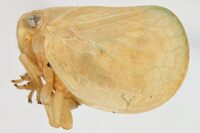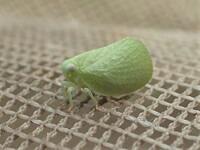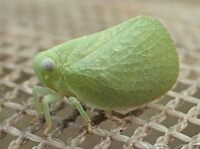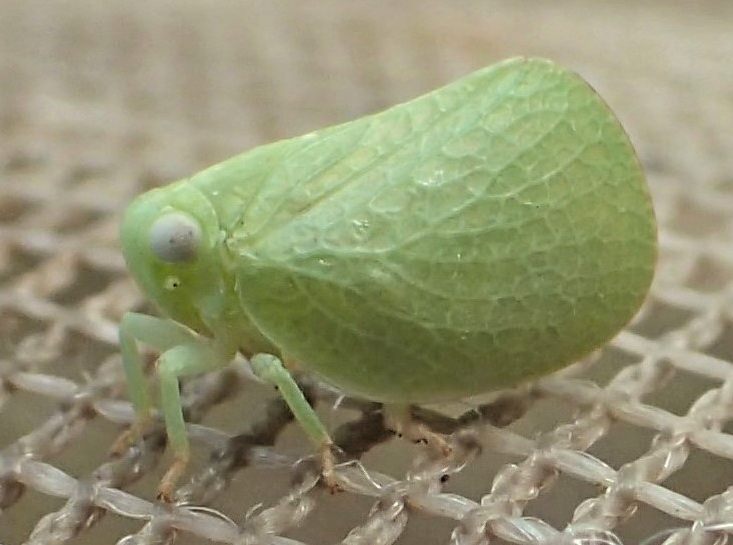
|
|
|
| synonym |
|
| description |
A very small member of this genus, tiny compared to the other Acanalonias. The vertex (head) gradually rounds from the eyes, and the costal margin of the wing is narrowly reflexed; the wings are heavily reticulared (UDEL). The 5th instar nymph of this species (which has been described) has a broad, nearly straight (or flat) head; the vertex is nearly twice as broad as long, and the face has an irregular row of sensory pits near each margin (FLEN). The eyes are large and prominent, with ocelli lacking. The nymph appears hump-backed, with sensory pits covering various parts of the whole body. Nymphs are pale cream to brownish in color, with a mottled appearance. The penultimate instars are strongly mottled and marked with light to dark brown. Nymphs are 3.9 mm long.
For more information on the nymphs, including some drawings, see: FLEN. For more images of this species, see: BG. |
| distribution |
Southeastern United States; also Bermuda, Cuba and the Isle of Pines, and Mona Island off Puerto Rico (FLEN); also Bahamas |
| abundance |
Strictly coastal, recorded from a couple counties in the southeastern portion of the coast; possibly more abundant in other coastal counties. This species has been reported as locally common in coastal sea grasses at times. |
| seasonal_occurrence | |
| habitat |
Coastal see grasses |
| plant associates |
Borrichia arborescens (tree seaside tansy; Asteraceae), Argusia gnaphalodes (sea rosemary; Boraginaceae; as Mallotonia gnaphalodes); Batis maritima (turtleweed; Bataceae) [this is the primary host plant], Salicornia depressa (Virginia glasswort; Chenopodiaceae, as Salicornia virginica), Suaeda linearis (annual sea-blite; Chenopodiaceae) (UDEL) |
| behavior |
|
| comments |
This is a very uncommon to rare species; there are few specimens of the adult. This species is likely very sensitive to coastal developments and thus requires protection and preservation of habitats. |
status |
[Native:]
[Introduced:]
[Extirpated:] | | list_type |
[Official:]
[Provisional:] |
| adult_id | Unmistakable and widely known Identifiable from good quality photos of unworn specimens
Identifiable from photos showing undersides, or other specialized views [e.g., legs, face]
Identifiable only by close inspection of structural features or by DNA analysis NULL |
| nymph_id | Unmistakable and widely known Identifiable from good quality photos, especially where associated with known host plants
Identifiable from close inspection of specimens or by DNA analysis
Identifiable only through rearing to adulthood NULL |
| G_rank |
GNR [G4G5] |
| S_rank |
[SU] |
| rank_comments |
r - Only a few historic records for NC; feeds on a variety of forbs in coastal marsh habitats |
| tribe |
|
| subgenus |
|
Species Photo Gallery for Acanalonia pumila No Common Name |
 | Photo by: C.W. & L.B. O'Brien
Out Of State Co.
Comment: photos copyright Charles Bartlett, rnspecimen ID: UDCC_TCN 00054951rnactual date: June 13, 1965 |  | Photo by: C.W. & L.B. O'Brien
Out Of State Co.
Comment: photos copyright Charles Bartlettrnspecimen ID: UDCC_TCN 00054951rnactual date: June 13, 1965 |
 | Photo by: C.W. & L.B. O'Brien
Out Of State Co.
Comment: photos copyright Charles Bartlett, rnspecimen ID: UDCC_TCN 00054951rnactual date: June 13, 1965 |  | Photo by: Robert Packard
Brunswick Co.
Comment: Photo has coordinates. It is also on I-naturalist. Captured by insect net. |
 | Photo by: Robert Packard
Brunswick Co.
Comment: Photo has coordinates. It is also on I-naturalist. Captured by insect net. |

 »
»



 »
»

